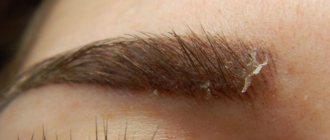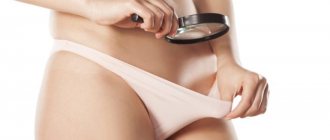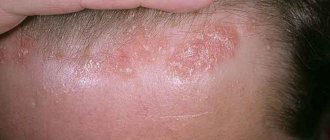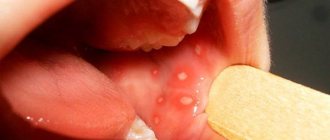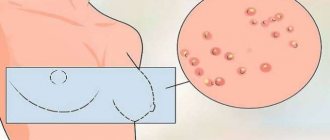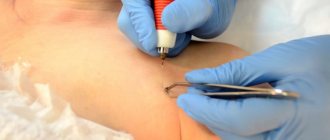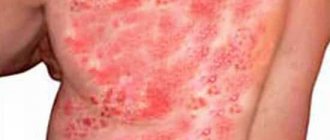Around the nipple are the Montgomery tubercles, glands that moisturize the areola. The appearance of various spots is most often associated with hormonal imbalance or blockage of glands. Redness may indicate the development of an inflammatory process, allergies or dermatitis. Spots on the nipples require detailed attention and examination. The ICD-10 disease code according to the international classification is N60-N64. It is important to understand the causes of the disease and find out whether there is a danger to general health.
Types of spots on the sternum in women
Doctors identify several main types of spots, which can be used to identify a problematic organ or even a disease in the body. It is advisable to start taking measures immediately after symptoms appear; in the future, this will save a lot of time and effort and will help maintain the health of the body.
Brown
Initially, one small spot appears, the skin on which begins to peel off.
The disease progresses and several spots appear, they are very itchy and inflamed. Doctors recommend using medicinal ointments and nitrofungin solution.
What could cause:
- allergic reaction of the body (brown spots appear rarely);
- lichen;
- cancer;
- insect bites;
- constantly being in stressful situations.
If you do not monitor the course of the disease from the very beginning, the brown spots merge into solid ones, and the itching becomes stronger. This type of spots indicates the presence of lichen or armored cancer. Both diseases need to be noticed at an early stage to prevent the patient’s well-being from deteriorating.
Note! In the case of cancer, you should be careful; if you start therapy with an undeveloped tumor, the chance of recovery is about 50-80%, depending on the organ affected by cancer.
Reds
The causes of redness of the skin in the chest area are varied. This may be related to the immune or hormonal systems, but in most cases, red spots appear when:
- vegetative-vascular dystonia;
- mastitis;
- cancer;
- skin diseases, such as urticaria;
- food allergies.
Red spots cause more discomfort than brown ones. It's easier to notice them. You should not ignore the appearance of redness, because it signals a person that there is some kind of health problem.
If treatment is delayed, the disease will enter an extremely severe phase, so in case of mastitis, it is possible to perform an operation, during which a breast incision will have to be made.
Note! In the case of a breast cancer tumor, if therapy is not carried out on time, death is possible. It is better not to ignore problems associated with the chest area.
Small specks
The most common cause of chest rash is urticaria. This disease occurs quite often in pregnant women and can signal that there is some kind of malfunction in the body.
If the following symptoms appear along with small red spots, you need to take urgent measures and go to the clinic:
- temperature rises;
- there is a headache;
- dizziness;
- eyes become inflamed;
- inflammation of the mucous membranes.
If the red spots itch and at least one of the symptoms is present, then it could be measles. When starting treatment, you should know that the rash will go away only two weeks after the final recovery.
If, during the course of the disease, the lymph nodes become inflamed, and the temperature remains high only for a short period of time, then this is rubella.
Rubella is an infectious viral disease; in most cases, a woman survives the disease without complications, but there are exceptions. However, the virus is quite easily transmitted to others, so during treatment it is better to avoid long-term contact with people.
Vitiligo disease
One common cause of white spots is the autoimmune skin disease vitiligo. This is a fairly serious pathology that is found in people of different ages and both sexes. The main signs of the disease: milky white spots with clear outlines, and no peeling is observed. Over time, the spots increase in size and connect with each other, the hair in the affected areas also becomes discolored. The location of the affected areas can be anywhere except the palms and soles of the feet. In a number of cases, spontaneous disappearance of defects is recorded (Fig. 1).
The following reasons for the development of vitiligo are noted:
- genetic predisposition;
- decreased immunity as a result of severe forms of viral diseases;
- autoimmune diseases: diabetes mellitus, thyroid pathologies;
- stress;
- physical and psychological overload;
- Addison's disease;
- alopecia areata;
- systemic sclerosis;
- hormonal imbalance and dysfunction of the pituitary gland and hypothalamus;
- intoxication of the body associated with parasitic influence;
- poisoning with phenol, heavy metals and other harmful substances.
The disease is most often caused by liver pathologies.
Causes of spots on the chest in women
Various skin rashes indicate the presence of some kind of disease. Hence the need to consult a doctor if the cause has not been established.
In medical practice, there have been situations when people ignored the first symptoms (in the form of red or brown spots) for the following diseases:
- scarlet fever;
- chickenpox;
- prickly heat;
- syphilis;
- allergic dermatitis.
Most of the diseases that are accompanied by skin rashes in the chest area are dangerous to human health.
In the chest area is the mammary gland. Any slight impact in its area indicates the presence of diseases associated with:
- work of the gastrointestinal tract;
- liver diseases;
- vitamin deficiency;
- skin reaction to light rays;
- taking hormonal medications;
- taking certain contraceptives;
- problems with the thyroid gland;
- renal failure;
- injury to the skin.
Sometimes you can find the cause of spots on the breasts of women on your own, but in most cases it is better to consult a dermatologist or therapist to be sure of the diagnosis.
Problems with the skin in the mammary gland area also arise due to the ingestion of some chemically active additives. Before use, it is advised to undergo tests at the hospital and make sure that the use of the drug will not cause harm to the body.
In some cases, red spots appear due to a large amount of antibiotics in the body. People mistakenly believe that if they just stop taking medications, they will get rid of their problems.
This is fundamentally wrong, because antibiotics stay in the body for a long time and sometimes help it fight other diseases. If you stop taking medications without a doctor's prescription, you can worsen not only skin diseases, but also others.
Note! For people suffering from drug or alcohol addiction, it is natural to experience a rash in the form of a rash on the chest. This occurs due to exhaustion of the body and lack of important vitamins.
Congenital pathology
Skin pigmentation disorders may be associated with a congenital deficiency of melanocyte cells that produce the necessary pigment. This phenomenon is called albinism.
The main purpose of melanin is protection against the influence of solar ultraviolet radiation. With a lack of this component, the skin becomes insufficiently protected from sunlight. In case of excessive exposure to ultraviolet radiation, white spots appear on the back. Such skin defects, once occurring, can remain on the body for a very long time, perhaps for life. Another congenital cause may be tuberous sclerosis, which causes numerous small whitish plaques on the skin.
Diagnostic methods
The most reliable way is to consult a doctor if you notice symptoms. In some cases, you can use self-diagnosis.
Self-diagnosis
When the first symptoms appear, if they are painless, you can carry out a number of procedures that will help determine the disease.
Sample instructions:
- Check for any hard lumps in the chest area.
- Palpate the breasts and if any deviations are noticed (changes in the shape of the nipples, the nipples become more retracted or swollen), then inform the doctor.
- Special attention should be paid to the color of the chest. If it remains the same, then everything is fine.
- It is worth checking the armpit area as well. This should be done with gentle circular movements.
- If necessary (if there is any pain), you need to move your arms, wait until the pain is felt and observe the chest in this position for some time.
Which doctor should I contact?
If during self-diagnosis any violations were noticed, then clinical diagnostics should be used.
The most acceptable solution is to sign up for a session with a dermatologist; if the cause of the skin disease is a problem with the internal organs, then be additionally examined by a surgeon and mammologist. In this case, it will be necessary to conduct an ultrasound to make sure there are no serious diseases.
Note! You should not trust self-diagnosis too much; the manifestation of the disease may not be noticeable at first. Doctors in the hospital will make a diagnosis more efficiently and reliably.
Possible complications
When diaper rash appears under the breast, there is a risk of developing a fungal disease
Diaper rash, itching and red spots under the mammary glands cause discomfort and can cause more serious illnesses. Especially if the patient forgets about personal hygiene measures or tries to cope with the problem on his own:
- skin infiltration is likely to develop;
- scratching the affected areas may cause bleeding wounds;
- infection on damaged skin often causes large-scale inflammation over a large area of skin;
- the risk of pyoderma or fungal skin diseases increases.
If hyperemia is detected in the area under the breasts, you should stop self-medicating and undergo a medical examination as soon as possible.
Treatment of spots on the chest
Spots on the chest should be treated in a timely manner so that this process does not turn out to be harmful to health. There are three treatment options:
- Medication.
- Using folk remedies.
- With the help of cosmetics.
Medication method
It is not recommended to use this method on your own if the exact diagnosis is not known. In case of an allergic reaction of the body, the following drugs are prescribed:
- diazolin;
- suprastin.
If the disease is associated with serious problems of internal organs, then special prescription drugs are prescribed. They can be obtained only on the orders of the attending physician.
In some cases, anti-inflammatory steroid drugs are prescribed.
Let's celebrate! The medicinal method of combating spots on the chest in most cases does not fight the skin disease, but the cause of the redness, rash or spots. This method differs from others in its reliability and health benefits.
Using folk remedies
Sometimes the cause of redness in the chest area is stress. In this case, folk remedies will help get rid of negativity and not cause harm to the body, unlike the use of strong sedatives.
It is recommended to use various herbal tinctures (sage, chamomile). There are special recipes that will help get rid of itching and redness:
| Name | Application |
| Parsley juice | Stir with honey, milk or lemon juice, then apply the resulting solution to the most problematic areas of the skin and leave for 10-15 minutes. Rinse with warm water, after the skin becomes dry, use a moisturizing and nourishing cream. |
| Lemon juice | Mix in equal proportions with honey. Apply the resulting substance to a napkin and apply it to problem areas. After 30 minutes, treat the skin with cream. |
| Fresh cucumber | Peel, chop, mix with honey and vegetable oil in equal proportions. Apply to stains, leave for 20-30 minutes, rinse with cold water and treat problem areas with nourishing cream. |
Using cosmetics
Before using the method, you need to understand that in this case, the cause of the appearance of spots in the breast area and in the woman will not be eliminated unless you additionally take medications as prescribed by the attending physician.
Cosmetics will help improve the overall condition of the skin:
- increase water balance;
- relieve skin from peeling;
- eliminate itching.
However, simply using washing foam or cream will not be enough; it is advisable to use the following services:
- Peeling. The skin is cleansed of dead epidermal cells. Using acid (safe for health), the top layer of skin is exfoliated and problem areas are treated. The procedure should be done after consultation with a cosmetologist.
- Laser therapy. A fairly safe method, you can achieve the desired result in 4 sessions. There are practically no contraindications.
Cosmetologists advise to first establish the cause of the spots, and then fight them so that the procedures are not in vain.
The appearance of spots on a woman’s chest indicates the development of some disease. You should not ignore the symptoms, because a person’s life may be in danger.
Let's celebrate! Sometimes a rash or redness appears due to a short-term allergic reaction, but the best solution is to consult a dermatologist or surgeon.
Infectious forms of damage
Whitish lesions on the skin caused by infectious factors can be the result of the following pathologies: syphilis, leprosy, pityriasis alba and pityriasis versicolor. White spots on the back are mainly caused by pityriasis versicolor.
This type of lichen is caused by the fungus Pityriasis orbiculare or the fungus Malassezia furfur. Some of the enzymes that the fungus secretes suppress the production of melanin by melanocytes. Due to a deficiency of pigment, the affected skin areas do not darken when exposed to sunlight, which is manifested by clear white spots on the back after sunbathing. At the initial stage of development, the spots may have a pink tint, but then the skin layer becomes whitish and flaky. The most common location is the upper areas of the body (shoulders, chest, upper back). The pathology may be marked by itching in the affected area, but most often other symptoms do not appear.
The main task of treatment is to destroy the fungus. Treatment is carried out comprehensively, and its scheme is selected taking into account the degree of development of the process and the severity of symptoms. The therapeutic effect is provided by external agents (ointments, solutions, soap) that can suppress the fungus. Treatment of the affected area with a solution of salicylic alcohol or apple cider vinegar is widely used.
Syphilitic leukoderma is most often localized on the neck in the form of a necklace, but can involve the upper back. Characteristic symptoms: round spots with a brighter halo around them. Defects can have different sizes. Treatment is aimed at eliminating the underlying disease.
Is pigmentation restored?
Independent restoration of the usual skin color on a woman’s mammary glands is possible only after cessation of lactation.
Diagnostic activities are carried out according to the protocols of the World Health Organization. What is included in a standard examination for suspected breast diseases:
- examination and palpation of the gland;
- A family history is required. Particular attention is paid to cases of breast cancer in the patient’s relatives;
- Ultrasound to determine the shape, changes in the structures of the organ;
- mammography – x-ray examination of the breast;
- biopsy - in the presence of compactions, to determine the nature of the formation;
- MRI – for confirmed neoplasm in the mammary gland;
- nipple smear, blood and urine tests if a bacterial nature of the disease is suspected;
- blood test for hormones.
Pigmentation care
Caring for areas with increased pigmentation does not differ from the hygienic requirements for caring for the mammary gland.
The recommendations of experts are as follows:
- careful attitude towards the breast;
- use of comfortable underwear;
- do not use aggressive detergents and cosmetics;
- do not sunbathe topless either on the beach or in the solarium;
- follow the principles of healthy eating;
- If any warning signs appear - pain, bleeding or clear, purulent fluid - immediately contact a medical facility.
The best way to care for an area of hyperpigmentation without signs of a pathological process is to simply leave the skin alone and not focus on the dark spot.
Causes of darkening during pregnancy
During pregnancy, the body begins to produce specific hormones, without which the development of the baby is impossible. These substances support pregnancy and have an immunosuppressive effect. The new hormonal status provokes increased production of melanin, and the nipples will darken during pregnancy.
Discoloration of the nipples and areolas begins in the first trimester and continues throughout the entire period of gestation and lactation. At the same time, the mammary glands enlarge, the shape and size of the nipple changes, and colostrum is released in the later stages. The peak of changes occurs at 37–38 weeks of pregnancy.
The color of the nipple during pregnancy depends on the individual characteristics of the body. For some women, these are shades of brown, for others, the areola turns black. This is a physiological condition. It does not require treatment or cosmetic correction.

